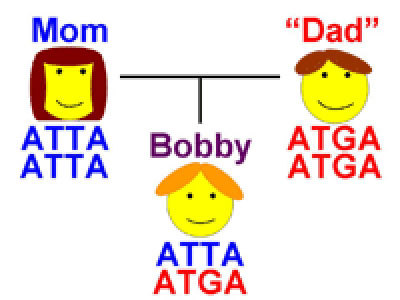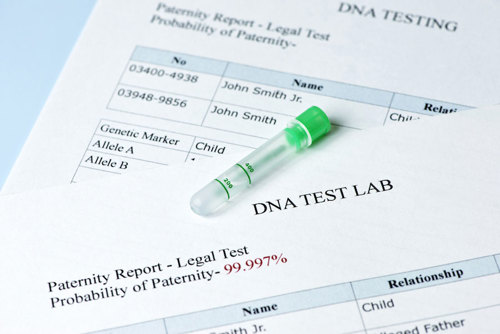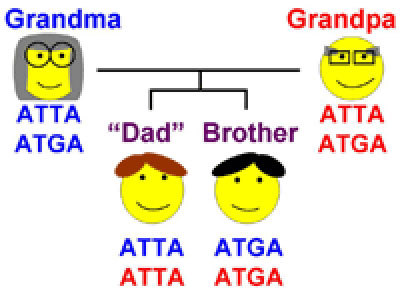
Can you tell other relationships from a paternity test?
June 11, 2008

- Related Topics:
- Paternity tests,
- Relatedness
A curious adult from California asks:
“Can you tell other relationships from a paternity test? Let’s say a man was tested for paternity of a child and the result was 99.99996%, and the man’s brother was tested for paternity of the same child and it came out 0%. Could you still compare the results on paper and tell if the child, man and brother were related only by looking at the results on paper and not doing another test?”
Editor’s Note (5/23/2022): At the time this article was written, the small number of markers used in paternity tests meant that it would be hard to say if the man and brother were related without doing another test. Today, paternity tests now use more markers and can sometimes detect uncle/aunt relationships. However, ancestry-type tests are better at detecting relatedness.
That's quite a mouthful! Basically you're asking if you can tell if son, father and uncle are all related from a simple paternity test. The answer is probably not.
There just isn't enough information to be able to do this without the child's grandparents' DNA. With that information, you would have a pretty good shot at seeing that the three are related.
To understand why this is, we need to dig a bit deeper into how a paternity test works. And what it can and cannot tell you.
Paternity Testing
As you know, a paternity test is a way to tell if a man is the biological father of another person. We'll call the man “dad” and the potential son “Bobby”. The way a paternity test works is that a scientist compares a child's DNA to the mother's and potential father's DNA. If half the child's DNA looks like mom's and the other half looks like the potential dad's, then the man is probably the child's father.
The reason this works is that we get half our DNA from our moms and half from our dads. But how do you compare DNA? You look at something called the DNA sequence.
DNA is made up of four bases that are represented by letters: A, T, C, and G. Everybody, except identical twins, has a unique combination of these letters. In other words, everyone has different DNA. The order of these letters is the DNA sequence.
So this is easy, right? Just compare the DNA sequences of the child to sequences of mom and dad, and see if they match.
Unfortunately, it is trickier than this. Sequencing all of someone's DNA is very expensive. This means we only compare snippets of DNA (scientists call these markers).
Let's walk through a paternity test with “dad” and Bobby. If we are trying to figure out if “dad” is Bobby's biological father, we take DNA from mom, Bobby, and “dad.”
Let's say Bobby has two copies of a certain marker: ATTA and ATGA. If mom gave him ATTA, then his biological father must have given him ATGA. If “dad” has ATGA, then the chances of him being Bobby's biological father increase.

Of course, lots of men probably have ATGA, too. We can solve this by looking at more than one marker. It's unlikely that a lot of men have a lot of markers that match Bobby's. We look at a lot of markers and compare Bobby's markers to the mom's. Anything that didn't come from mom must have come from the biological father, so we compare those markers to “dad's” markers. If enough of the markers match “dad's”, we can say that the odds are good that "dad" is the biological father. If not, it must be some other guy.
How do geneticists arrive at the odds? They first take all the markers that match “dad” and consider how often they occur in “dad's” ethnic group. Markers occur at different frequencies in different ethnic groups. Geneticists multiply all of these frequencies together to determine what is called a “combined paternity index”, which is basically just a number that represents the odds of “dad” being the biological father.
So they get something like “dad” is 134,525,234 times more likely to be the father than a random man in the same ethnic group. They then convert this number to a percentage, which represents the likelihood of the “dad” being the biological father.

Usually, geneticists use a cutoff of 99.9% to determine paternity, which means that there is less than a 1 in 1000 chance of a random person's markers matching Bobby's. If this is the case, they deem "dad" the biological father.
Shouldn't all the markers match? In a perfect world, yes. But our cells are not perfect. They make an occasional mistake that can show up in Bobby's DNA. That's why 99.9% is good enough.
More Distant Relationships
OK, so that's how a paternity test works. So why can't it tell us that the three men are related? After all, the paternity tests gave us all of the markers of “dad” and his “brother”. Can't we just compare “dad's” markers to “brother's” like we did with Bobby and “dad”?
The answer is no. It has to do with the fact that we get half our DNA from mom and half from dad. And the half we get is random. What this means is that two brothers might have different DNA from their mom and dad.
Let's go back to our ATTA and ATGA markers. Imagine that the brothers' dad has an ATTA and an ATGA and that their mom also has ATTA and ATGA. Let's say one brother randomly got an ATTA from their mom and an ATTA from their dad. And the other brother got an ATGA from both of them.

If we look at this marker in the brothers without knowing their parents' DNA, we might conclude they weren't related because they have different markers. And we'd be wrong.
Of course, the chances of this happening at every marker aren't high. Odds are that the brothers will share at least some markers. However, they won't share enough markers for scientists to definitively say that they are related. To tell if they are brothers, we really need to have the DNA of at least one of their biological parents.

Author: Andrew Hellman
When this answer was published in 2008, Andrew was a Ph.D. candidate in the Department of Biology, studying synapse formation in Kang Shen's laboratory. Andrew wrote this answer while participating in the Stanford at The Tech program.
 Skip Navigation
Skip Navigation
